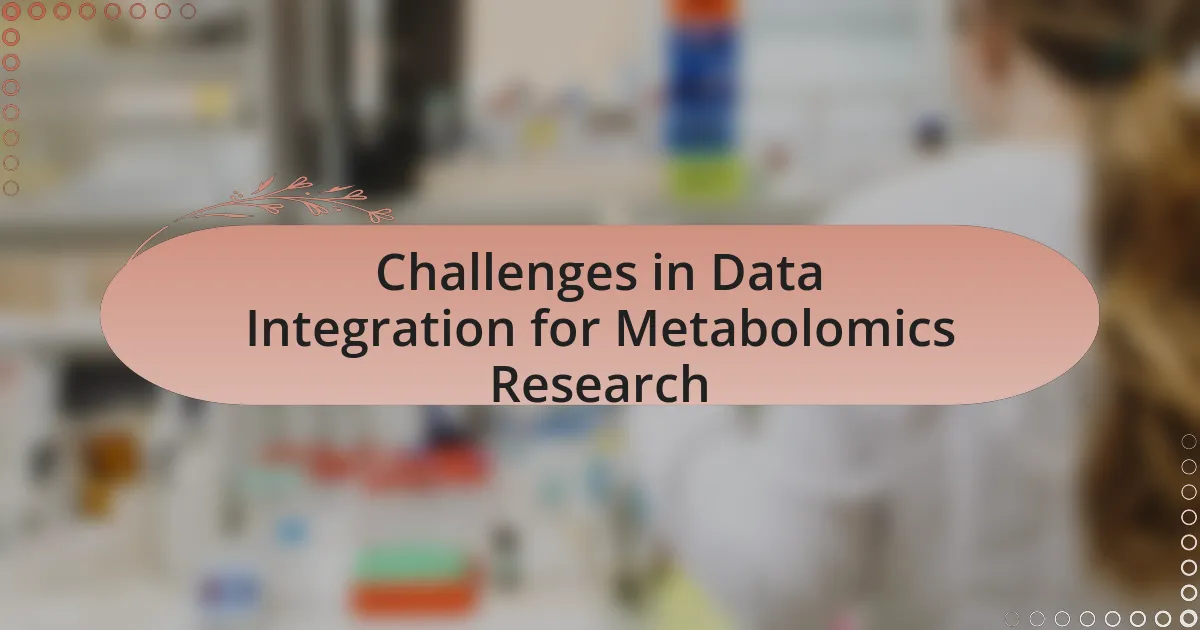Metabolomics is the comprehensive study of metabolites within biological systems, crucial for understanding metabolic processes and responses to environmental changes. This article explores the role of metabolomics in environmental monitoring, highlighting its ability to detect biochemical changes in organisms exposed to pollutants and stressors, thereby serving as indicators of ecosystem health. Key techniques such as mass spectrometry and nuclear magnetic resonance spectroscopy are discussed, along with the advantages of metabolomics over traditional monitoring methods. The article also addresses the applications of metabolomics in assessing pollution levels, biodiversity studies, and conservation efforts, while identifying challenges and future directions for enhancing its effectiveness in environmental assessments.
What is Metabolomics and its Role in Environmental Monitoring?
Metabolomics is the comprehensive study of metabolites within biological systems, providing insights into metabolic processes and responses to environmental changes. In environmental monitoring, metabolomics plays a crucial role by enabling the detection of biochemical changes in organisms exposed to pollutants or stressors, thereby serving as a sensitive indicator of ecosystem health. For instance, studies have shown that metabolomic profiling can reveal the impact of heavy metals on aquatic organisms, allowing for early detection of environmental degradation. This approach enhances traditional monitoring methods by offering a more detailed understanding of the biochemical effects of environmental factors, ultimately aiding in the assessment and management of ecological risks.
How does metabolomics contribute to understanding environmental changes?
Metabolomics contributes to understanding environmental changes by providing insights into the biochemical responses of organisms to their surroundings. This field analyzes the small molecules, or metabolites, present in biological samples, which can reflect the physiological state of an organism in response to environmental stressors such as pollution, climate change, and habitat alteration. For instance, studies have shown that shifts in metabolite profiles can indicate changes in nutrient availability or toxic exposure, allowing researchers to assess ecosystem health and resilience. By integrating metabolomic data with environmental monitoring, scientists can identify biomarkers of environmental change, facilitating early detection and management of ecological impacts.
What are the key techniques used in metabolomics for environmental studies?
The key techniques used in metabolomics for environmental studies include mass spectrometry (MS), nuclear magnetic resonance (NMR) spectroscopy, and chromatography. Mass spectrometry is widely utilized for its sensitivity and ability to analyze complex mixtures, allowing researchers to identify and quantify metabolites in environmental samples. Nuclear magnetic resonance spectroscopy provides detailed structural information about metabolites, facilitating the understanding of metabolic pathways and interactions in ecosystems. Chromatography techniques, such as gas chromatography (GC) and liquid chromatography (LC), are essential for separating metabolites before analysis, enhancing the accuracy of metabolomic profiling. These techniques collectively enable comprehensive assessments of environmental changes and their impacts on biological systems.
How do metabolomic profiles indicate environmental stressors?
Metabolomic profiles indicate environmental stressors by revealing specific changes in metabolite concentrations that correlate with exposure to harmful conditions. For instance, when organisms are subjected to pollutants or extreme temperatures, their metabolic pathways are altered, leading to the accumulation or depletion of certain metabolites. Studies have shown that increased levels of stress-related metabolites, such as amino acids and organic acids, can serve as biomarkers for environmental stress. This relationship has been documented in research, such as the study by Fiehn et al. (2000), which demonstrated that metabolomic analysis can effectively differentiate between stressed and non-stressed biological samples, thereby providing a reliable method for environmental monitoring.
Why is metabolomics important for environmental monitoring?
Metabolomics is important for environmental monitoring because it provides comprehensive insights into the biochemical changes in organisms due to environmental stressors. By analyzing metabolites, researchers can detect alterations in biological pathways that indicate pollution, climate change, or habitat degradation. For instance, studies have shown that specific metabolite profiles can serve as biomarkers for exposure to contaminants, enabling early detection of ecological impacts. This approach enhances the understanding of ecosystem health and facilitates timely interventions to mitigate environmental damage.
What advantages does metabolomics offer over traditional monitoring methods?
Metabolomics offers several advantages over traditional monitoring methods, primarily through its ability to provide a comprehensive and dynamic snapshot of metabolic changes in organisms and environments. This approach allows for the detection of a wide range of metabolites, which can reveal insights into physiological states, stress responses, and environmental interactions that traditional methods may overlook. For instance, metabolomics can identify specific biomarkers associated with environmental stressors, enabling more precise assessments of ecosystem health. Additionally, the high-throughput nature of metabolomics facilitates rapid data collection and analysis, making it possible to monitor changes in real-time, which is often not feasible with conventional techniques.
How can metabolomics enhance our understanding of ecosystem health?
Metabolomics enhances our understanding of ecosystem health by providing comprehensive insights into the biochemical processes occurring within organisms and their environments. This field analyzes the metabolites present in biological samples, which reflect the physiological state of organisms and their responses to environmental changes. For instance, studies have shown that shifts in metabolite profiles can indicate stress responses in aquatic organisms due to pollution or climate change, allowing for early detection of ecosystem disturbances. By integrating metabolomic data with ecological assessments, researchers can identify biomarkers of ecosystem health, track changes over time, and develop strategies for conservation and management.
What are the Applications of Metabolomics in Environmental Monitoring?
Metabolomics is applied in environmental monitoring to assess the health of ecosystems, track pollution levels, and evaluate the impact of climate change. By analyzing the metabolic profiles of organisms, researchers can detect changes in biochemical pathways that indicate environmental stressors, such as heavy metals or pesticides. For instance, studies have shown that metabolomic approaches can identify specific biomarkers in aquatic organisms that reflect water quality and contamination levels, providing a sensitive and rapid assessment tool for environmental health.
How is metabolomics applied in assessing pollution levels?
Metabolomics is applied in assessing pollution levels by analyzing the metabolic profiles of organisms exposed to environmental contaminants. This approach allows researchers to identify specific metabolites that change in response to pollutants, providing insights into the biological effects of pollution. For instance, studies have shown that the presence of heavy metals can alter the metabolomic signatures in aquatic organisms, indicating stress and toxicity levels. By utilizing techniques such as mass spectrometry and nuclear magnetic resonance, scientists can quantitatively measure these metabolites, enabling the assessment of pollution impact on ecosystems.
What specific metabolites are indicators of pollution?
Specific metabolites that indicate pollution include polycyclic aromatic hydrocarbons (PAHs), heavy metal ions, and nitrogenous compounds such as nitrates and nitrites. PAHs are organic compounds formed from the incomplete combustion of fossil fuels and are known to be toxic and carcinogenic, making them reliable indicators of environmental contamination. Heavy metal ions, including lead, cadmium, and mercury, accumulate in organisms and ecosystems, leading to detrimental health effects and serving as markers for pollution. Nitrogenous compounds, particularly nitrates and nitrites, are often associated with agricultural runoff and wastewater discharge, indicating nutrient pollution that can lead to harmful algal blooms. These metabolites are widely studied in environmental monitoring due to their clear associations with specific pollution sources and their impacts on ecosystems and human health.
How do metabolomic analyses inform pollution mitigation strategies?
Metabolomic analyses inform pollution mitigation strategies by providing detailed insights into the biochemical changes in organisms exposed to pollutants. These analyses enable the identification of specific metabolites that indicate the presence and impact of environmental contaminants, allowing for targeted interventions. For instance, studies have shown that metabolomic profiling can reveal stress responses in aquatic organisms exposed to heavy metals, facilitating the development of effective remediation techniques. By linking metabolite changes to pollution levels, researchers can assess the effectiveness of mitigation strategies and adapt them based on real-time biological responses, ultimately leading to more efficient environmental management practices.
What role does metabolomics play in biodiversity studies?
Metabolomics plays a crucial role in biodiversity studies by providing insights into the metabolic profiles of organisms, which can reveal their physiological responses to environmental changes. This approach allows researchers to assess the health and diversity of ecosystems by analyzing the metabolites produced by various species, thereby identifying biomarkers of stress or adaptation. For instance, studies have shown that specific metabolite patterns can indicate the presence of pollutants or changes in habitat conditions, making metabolomics a valuable tool for monitoring ecosystem health and biodiversity.
How can metabolomics help in identifying species responses to environmental changes?
Metabolomics can help identify species responses to environmental changes by analyzing the small molecules produced during metabolic processes, which reflect physiological states. This analysis allows researchers to detect shifts in metabolic profiles that occur in response to stressors such as temperature fluctuations, pollution, or habitat alterations. For instance, studies have shown that specific metabolites can serve as biomarkers for stress responses, enabling the assessment of ecosystem health and species resilience. By employing techniques like mass spectrometry and nuclear magnetic resonance, scientists can quantitatively measure these metabolites, providing concrete data on how species adapt or fail to adapt to changing environments.
What are the implications of metabolomic data for conservation efforts?
Metabolomic data has significant implications for conservation efforts by providing insights into the physiological status and health of organisms, which can inform management strategies. This data allows researchers to identify biomarkers of stress, disease, and environmental changes, enabling targeted conservation actions. For instance, studies have shown that metabolomic profiling can reveal how species respond to habitat degradation or climate change, facilitating early intervention to protect vulnerable populations. Additionally, metabolomic data can enhance biodiversity assessments by revealing the metabolic diversity within ecosystems, which is crucial for understanding ecosystem resilience and function.
What are the Challenges and Future Directions of Metabolomics in Environmental Monitoring?
The challenges of metabolomics in environmental monitoring include the complexity of biological samples, the need for standardized methodologies, and the integration of large datasets for meaningful analysis. Biological samples often contain a vast array of metabolites, making it difficult to identify and quantify specific compounds accurately. Additionally, the lack of standardized protocols across different laboratories can lead to variability in results, hindering comparability. Future directions involve the development of advanced analytical techniques, such as high-resolution mass spectrometry and machine learning algorithms, to enhance data interpretation and facilitate real-time monitoring. These advancements aim to improve the reliability and applicability of metabolomics in assessing environmental health and ecosystem changes.
What are the current limitations of metabolomics in environmental studies?
The current limitations of metabolomics in environmental studies include challenges in data complexity, analytical sensitivity, and standardization. Data complexity arises from the vast number of metabolites present in environmental samples, making it difficult to identify and quantify them accurately. Analytical sensitivity is often insufficient for detecting low-abundance metabolites, which can lead to incomplete datasets. Additionally, the lack of standardized protocols for sample collection, processing, and analysis hinders reproducibility and comparability across studies. These limitations have been documented in various reviews, such as “Metabolomics in Environmental Science: A Review” by K. A. H. M. van der Werf et al., highlighting the need for improved methodologies and frameworks to enhance the applicability of metabolomics in environmental monitoring.
How can data integration improve the effectiveness of metabolomics?
Data integration can significantly enhance the effectiveness of metabolomics by enabling comprehensive analysis of complex biological data from multiple sources. By combining data from various platforms, such as mass spectrometry and nuclear magnetic resonance, researchers can achieve a more holistic understanding of metabolic pathways and their interactions. This integrated approach allows for the identification of biomarkers with greater accuracy and reliability, facilitating better environmental monitoring and assessment. Studies have shown that integrated metabolomic analyses can improve the detection of subtle metabolic changes in response to environmental stressors, thereby providing critical insights into ecosystem health and resilience.
What technological advancements are needed for better metabolomic analysis?
Advancements in high-resolution mass spectrometry and nuclear magnetic resonance spectroscopy are essential for improving metabolomic analysis. High-resolution mass spectrometry enhances the detection of low-abundance metabolites and provides accurate mass measurements, which is crucial for identifying complex mixtures. Nuclear magnetic resonance spectroscopy offers non-destructive analysis and structural elucidation of metabolites, allowing for a comprehensive understanding of metabolic pathways. Additionally, advancements in data processing algorithms and machine learning techniques are necessary to handle the vast amounts of data generated, enabling more efficient analysis and interpretation of metabolomic profiles. These technological improvements collectively enhance the sensitivity, specificity, and throughput of metabolomic studies, facilitating better environmental monitoring.
How can researchers overcome challenges in metabolomics for environmental monitoring?
Researchers can overcome challenges in metabolomics for environmental monitoring by employing advanced analytical techniques and standardizing methodologies. Utilizing high-resolution mass spectrometry and nuclear magnetic resonance spectroscopy enhances the sensitivity and specificity of metabolite detection, allowing for more accurate environmental assessments. Additionally, establishing standardized protocols for sample collection, processing, and data analysis can minimize variability and improve reproducibility across studies. For instance, the adoption of the Metabolomics Standards Initiative guidelines has been shown to facilitate data sharing and comparison, thereby strengthening the reliability of findings in environmental contexts.
What best practices should be followed for effective metabolomic studies?
Effective metabolomic studies should follow best practices that include rigorous sample collection, proper storage conditions, and standardized analytical methods. Rigorous sample collection ensures that samples are representative of the biological system being studied, while proper storage conditions, such as maintaining low temperatures and avoiding light exposure, prevent degradation of metabolites. Standardized analytical methods, including the use of validated protocols for mass spectrometry or nuclear magnetic resonance spectroscopy, enhance reproducibility and comparability of results. These practices are supported by research indicating that variability in sample handling and analysis can significantly affect metabolomic data quality, as highlighted in studies published in journals like “Metabolomics” and “Analytical Chemistry.”
What are the practical applications of metabolomics in environmental monitoring?
Metabolomics has practical applications in environmental monitoring by providing insights into the biochemical responses of organisms to environmental stressors. This approach enables the detection of pollutants and toxic substances in ecosystems, as metabolites can serve as biomarkers for exposure and effect. For instance, studies have shown that changes in metabolite profiles in aquatic organisms can indicate water quality and the presence of contaminants, allowing for early warning systems in pollution management. Additionally, metabolomics can be used to assess the health of ecosystems by analyzing the metabolic responses of plants and animals to environmental changes, thereby facilitating conservation efforts and ecosystem restoration.











